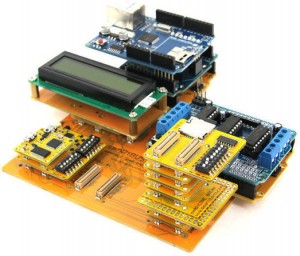Most projects on crowdfunding platforms such as Kickstarter, especially technology projects, end up being delayed weeks, months or sometimes even more than a year beyond their “estimated delivery” date. Why do these crowd-funded technology projects seem to get delayed?
What sorts of factors are responsible for the apparent lack of on-schedule progress commonly seen with technology projects on crowd-funded platforms, and what are some of the potential perils of crowdfunding the design and production of new technology products produced by amateur industrialists on these platforms?
Delays tend to correlate with the complexity of the project, the level of over-funding, lack of maturity of the prototype engineering (which is sometimes nothing more than concept art) at the beginning of the funding campaign, and the constraints of the team running the project – for example, are they working on this project only part-time or after hours, is the project run by an individual rather than a team, and is the project being attempted with no other funding sources?
Founders of crowd-funded projects tend to be optimistic about the imminent success of their idea or product – that’s why they launched their project in the first place. As optimistic project founders see their idea through rose-coloured glasses, and they believe that their idea is the exception to the rule, and that success is imminent.
By reading about the success of other contemporary projects, or the fictionalised ease of development for iconic products such as the original Apple computer – founders can often believe that their abilities are much greater than what is truthfully so. Which is a pity – as many great ideas can be derived from those with non-engineering backgrounds.
When launching a crowd-funding campaign, it’s easy to show the things that work and gloss over the things that don’t in the launch video. It’s easy to create a computer rendering of some artwork of what you imagine that your conceptual product might look like, or even a beautiful cosmetic model that looks good with no functionality, without having an actual prototype that addresses the actual engineering risk required to implement the technical claims for the product that you’re pitching.
While some crowd-funding platforms such as Kickstarter have tightened up their rules for technology projects in this regard, it can still be a problem. The prototype engineering possessed by project creators at the time of campaign launch is often rougher than what is shown in the video, or even non-existent, without any video or images provided to the backers that show close-up detail of functional, working prototypes.
This isn’t really a reason that crowd-funded projects get delayed past the “estimated delivery date” set by project creators, but this slightly misleading behaviour can be a reason why backers get the mistaken impression that technology projects are more developed than they actually are at the time of launch, leading to unrealistic backer expectations.
Anyone can draw a picture of a flying car and claim that it’s a working, existing prototype with no engineering risk, so to address the perceived problem with unrefined and over-promised technology or “gadget” projects on Kickstarter, new rules were enacted banning product renders and simulations with no real-world substance, and requiring project leads to explain the risks that exist in the process of making their idea a reality. Over the coming years we’ll see if this improves the punctuality and delivery success rate of Kickstarter technology projects.
Another reason for possible delays is the ever-present temptation for “feature creep”, addition of new features, engineering changes or improvements. In many cases, if a new feature or concept is developed that would clearly contribute to an improved product many project creators would happily trade off some delivery delay for a superior product.
Another important factor often seen in crowd-funded projects is that many amateur engineers and product designers have little or no concept of the importance of design for manufacturability – design, documentation, assembly, construction techniques and supply chains for materials and components that are compatible with large-scale industrial manufacturing – then working with regulatory agencies to have their product approved for use in major markets can cause complete product redesigns if not planned for originally.
This is especially important for “over-funded” crowd-funded projects where the demand for the product has significantly exceeded expectations. What happens when you set a goal of $10,000 for your Kickstarter project, but eventually collect fifty times that in pledges?
The scope tends to broaden, especially with very successful projects. Big funding can catalyse big, ongoing dreams – and pursuing these dreams inevitably bleeds into the process of delivering the core expectations of the campaign itself on the promised schedule. Larger than anticipated demand also requires that highly-scalable, high-volume manufacturing processes such as injection moulding for enclosures, where it may not have been originally intended for such manufacturing processes to be used.
Many DIY hobbyist mechanical and electronic construction projects that are hand-crafted need to be translated into a manufacturable design for scalability – PCB designs using standard photo-lithography file formats such as Gerber, with manufacturable design rules, metal and plastic parts for machining drawn up in an industry-standard fashion with materials and tolerances properly specified, cable assemblies designed and documented in a manufacturable way, etc.
Making a garage-made prototype into a design which is compatible with industrial manufacturability at any scale required can be a tricky business. DFM can be assisted by relying on the experience of your manufacturing partner and using their insights to drive design revisions, and/or by performing factory manufacturing of small sample or prototype runs, assessing the manufacturing process and the finished product and revising the design documents based on what you’ve learned.
Toolmaking for injection-moulded plastics is a well-known challenge for small or inexperienced hardware start-ups, due to its cost and the impracticality of iterative design. Even though a typical heat-treated steel injection-moulding die may be used to manufacture as many as a million plastic components at a very low cost before it needs replacement, the initial design and fabrication of the die can easily cost between $50,000 and $100,000. It can also take several weeks or months to make the tool, and if any changes or iterations of the plastic design are required then the same cost is required for a new die.
For a small hardware start-up with limited funding, mould tools really need to be designed and fabricated correctly the first time. Unfortunately, this is not easily compatible with agile, rapid iteration during your product development process, but options such as 3D printing for plastic prototyping, prototype die making in softer metals such as aluminium or diecast zinc and alternative manufacturing methods such as laser cutting, vacuum forming or thermoforming can reduce the cost burden of tooling for plastics manufacturing.
Designing your product using electronic components that can be sourced economically in sufficiently large volumes to meet scalable demand, and specifying a usable bill of materials with components sourced directly from their manufacturers and/or high-volume distributors is another potential cause of difficulties with manufacturability for designers moving into the production of a high-volume product for the first time.
It can also be difficult to convince a factory to work with you as a relatively small, new start-up, since factories tend to make their money on volume and start-ups generally can’t offer high-volume manufacturing. If a factory is willing to work with you on a moderately small volume manufacturing project it’s probably because they share your excitement about what you’re doing and they also hope that you’ll grow quickly, bringing more business for the factory along for the ride.
In short, the process of taking a great idea and developing it into a product via a crowd-funded platform can either be a total success or a complete failure. The difference in outcomes can be predicated by planning, research and teaming with experts in product design and manufacture.
If you’re considering launching the “next great thing” via a crowd-funded platform – or if you have the funding and are now at the “where do we go from here?” stage in your real product development, it pays to partner with an organisation that has experience in all stages of product design.
Here at the LX Group we have experience in short-run product development, and can scale your design for any quantity required. Don’t risk scaling up your product with hobbyist-level engineering – instead, join us for a confidential discussion about your ideas and how we can help bring them to life – click here to contact us, or telephone 1800 810 124.
LX is an award-winning electronics design company based in Sydney, Australia. LX services include full turnkey design, electronics, hardware, software and firmware design. LX specialises in embedded systems and wireless technologies design.
Published by LX Pty Ltd for itself and the LX Group of companies, including LX Design House, LX Solutions and LX Consulting, LX Innovations.



